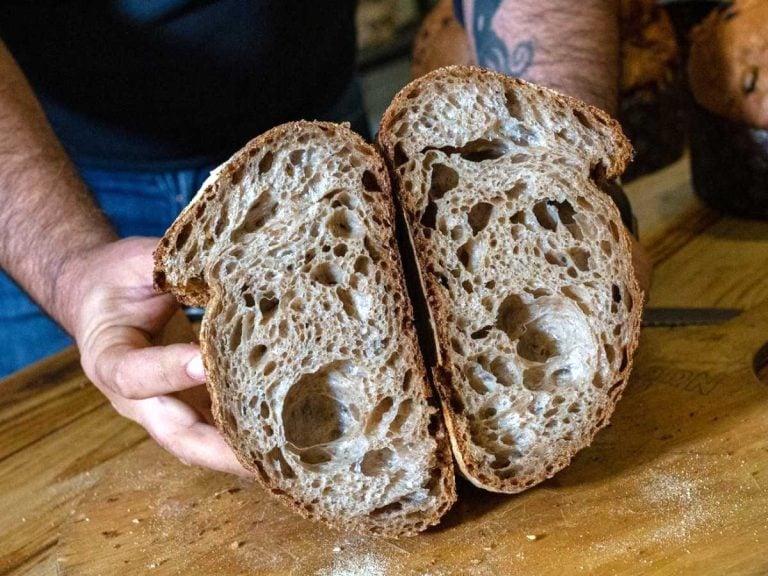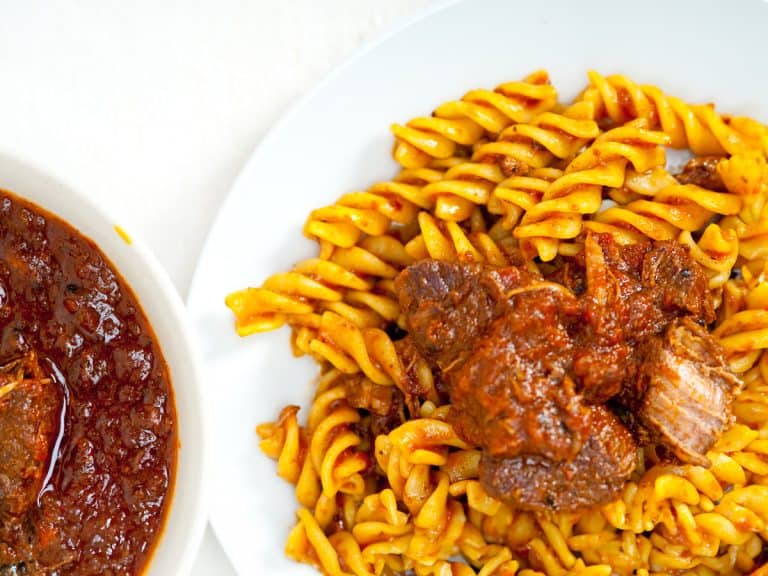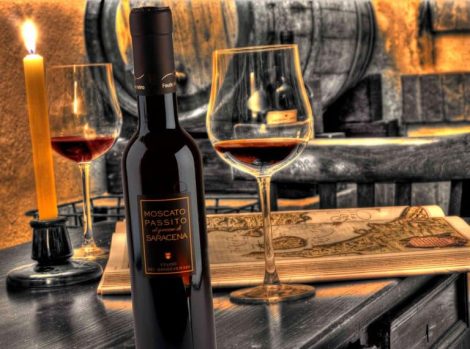This is just one small example of an exclusive and (often) wrong way of communicating bread. But the world (especially the marketing world) of flours and leavened products is full of communication "mistakes". We asked Carlo Di Cristo, baker at Foorn in Mariglianella and Naples - soon also on the Amalfi Coast - to dispel the most widespread myths, from large air pockets to stone-ground flours.
Large alveoli is not synonymous with good leavening
"Large alveoli are not very indicative of the quality of the leavening," explains Di Cristo. "For example, if they are hyper alveolated it is possible that the product is under-fermented. Granted that the alveolus that we see is not always a real cell where carbon dioxide has accumulated (in reality it can also be a kneading reaction that determines chambers to which we erroneously give the name of alveoli), we often see images of loaves with large alveoli but around an extremely dense internal structure". What does this mean in this case? "It's probably due to the use of a flour with a pronounced ability to expand and the baking of under-fermented dough, which causes an 'explosion' of alveoli during baking, and at the same time some areas of the crumb remain very dense (I'm not talking about micro alveoli), these are indications that the flour has not had time to transform".
Just as often, breads are passed off as hyper alveolated products, breads that have actually gone beyond fermentation: "You can recognise them with the naked eye, they are those breads that have large alveoli at the top, near the crust, and are crowded underneath." So, it is not necessarily the case that a bread with large alveoli is well leavened, as optimal leavening is the result of several factors, from the energy used in processing to the amount of water in the dough, from the state of the pastry to the type of flour used. There are, in fact, flours that do not allow for the development of large alveoli, such as rye flour or, more generally, flours with a low protein content: the protein content depends on a genetic characteristic of the grains that make it up, but also on the method of fertilisation, if a lot of nitrates are used in the fertilisation these are one of the sources of nitrogen that is needed to build the proteins.
Are flours from "ancient grains" more digestible?
That there is not enough scientific literature demonstrating the greater digestibility of breads made with flours from ancient grains (perhaps it is better to speak of autochthonous grains) is a fact - the populariser of science Beatrice Mautino chastised us following this article where we spoke of a single scientific article, but still not "digested", to stay on the subject, by the scientific community - but it is equally indisputable that when we (the author of the article) eat a bread made with flours from autochthonous grains we perceive it to be more digestible. Is this just a perception? "Flour is mostly made of starches and these are the easiest to digest. And it's not even a protein problem, just think of pasta which is also made of protein but a pasta is never left on the stomach. Protein, at most, creates a chewing problem: if I have used a flour with a high protein content and given it an inadequate processing time - so the protein is not processed properly - I will end up with a 'doughy' dough, a bit like chewing gum. The nutritional heaviness is related to other components, like the fat in dairy products or the added oil. And then human digestion problems are subjective and related to human microflora or other subjective characteristics, like stress level". To be honest, from a scientific point of view, the trend of the future will be to move towards non-digestibility. "In wheat, and therefore in flours, there is a share of starch that is resistant to digestion, now we are selecting grains in which the rate of starch that is resistant to digestion is higher and higher because it actually releases less sugar and therefore does not have a massive impact on glycaemic peaks. And here a magnifying glass is placed on the concept of digestibility: when we talk about digestibility, we are not referring to the subjective digestibility of the human being but to the digestibility of the flour's components."
Is stone-milled flour better?
"Not always". Di Cristo is categorical because indeed stone milling creates characteristics that one may or may not appreciate, but it does not mean that it gives a better product than cylinder milling. "Stone milling, for example, heats up a lot and implies the loss of micronutrients during milling, unless more sophisticated systems are used (the more structured mills combine the two milling processes), but at the same time the whole grain is milled and therefore all its essential parts remain in the flour. In general, a well-made stone-milled flour is an excellent product; the problem lies in the many mills scattered throughout Italy that do not respect the most basic safety standards and that offer poor quality flour, even with the presence of mycotoxins or rodent hair, and difficult to process. It is certainly no coincidence that more structured mills spend a large part of their square footage on cleaning equipment". Stone milling is therefore not enough to guarantee a quality product. It is necessary to go through cultivation techniques, the varieties chosen on the land, post-harvest treatments, the way the grain is stored, the mill's technological equipment, and the type of stone.
Last knot to unravel: is it better to use sourdough starter? "If I don't process the flour well, the product will suffer, regardless of the pastry used." Sourdough is fine, but only if managed and used correctly.


 Neapolitan or Bolognese? The (tomato-free) history of the two ragùs that divide Italy
Neapolitan or Bolognese? The (tomato-free) history of the two ragùs that divide Italy Dom Perignon for dogs and sleepless rock stars: the bizarre requests to the world’s best hotel manager
Dom Perignon for dogs and sleepless rock stars: the bizarre requests to the world’s best hotel manager The oil always moves north, reaching England. How the map of olive trees is changing due to climate change
The oil always moves north, reaching England. How the map of olive trees is changing due to climate change The Nobel Sandwich we tried at CERN, just steps from antimatter
The Nobel Sandwich we tried at CERN, just steps from antimatter The two young talents from Gattinara revolutionising Italian cuisine
The two young talents from Gattinara revolutionising Italian cuisine






